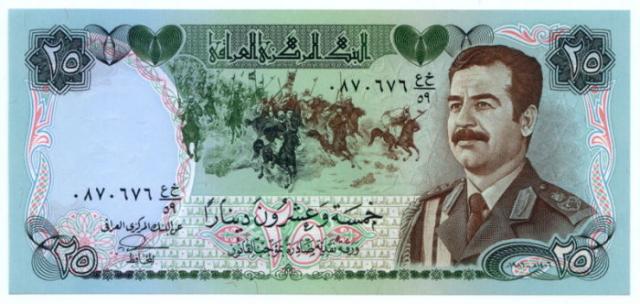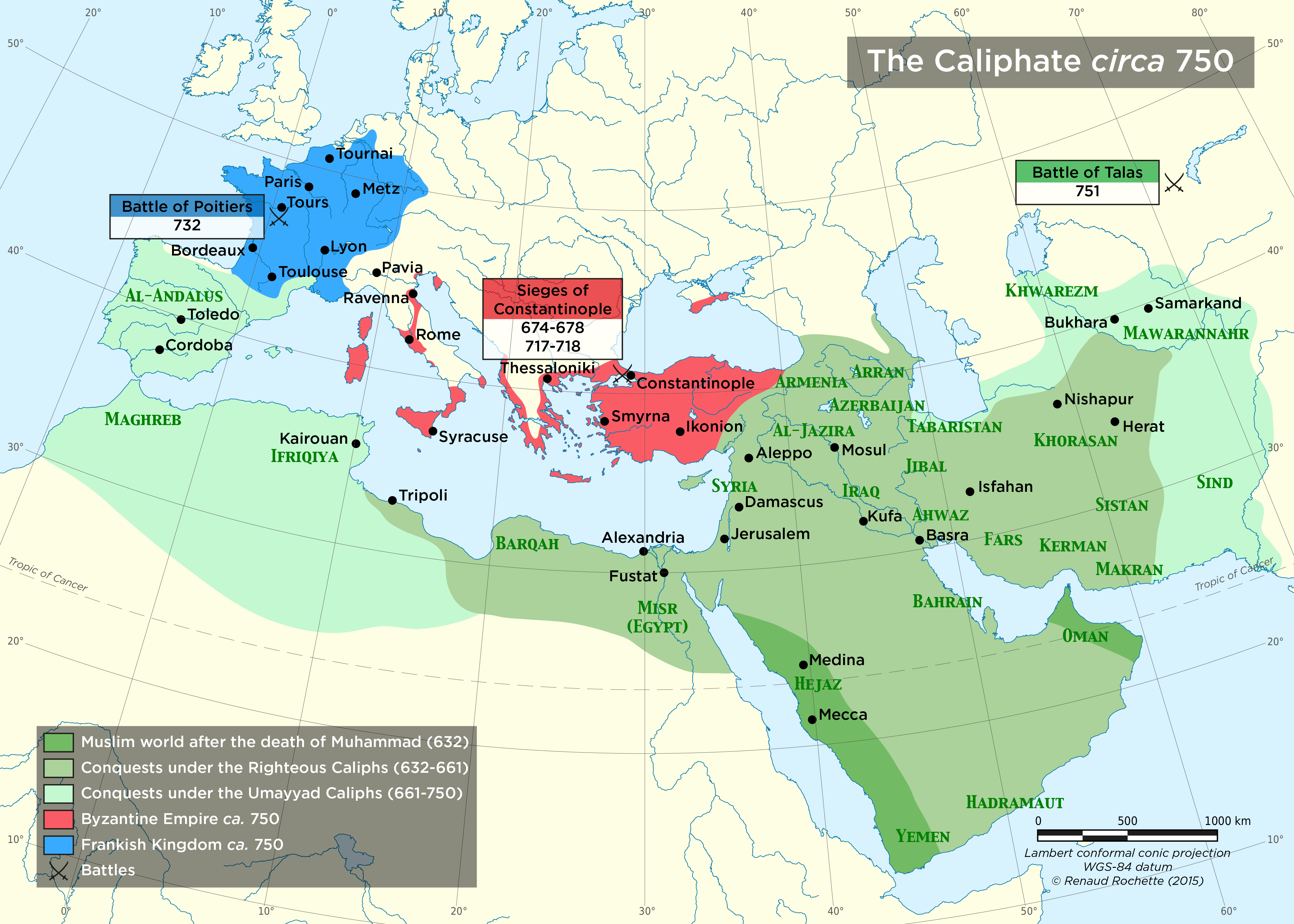2. The early Islamic conquests, 632-750
After the death of Muhammad, Arabia was forced to submit to the first Caliph. Then, under the time of the Caliphs 'Umar and' Uthmān, “riding nomads” driven by their faith and by the lure of looting marched on long distances, and earned their first military victories by defeating the Byzantine Empire and by conquering the rich eastern provinces of Syria and Palestine as well as Egypt, the breadbasket of the Empire. The Sassanid Empire didn't survive these defeats. The Arabs occupied Iraq and Iran. Within half a century, the Muhammadan message brought by Arab warriors - and its tribal dynamics - enforced an imperial political system on the conquered territories, from Iran to the Maghreb.
The second phase of conquests, a longer and more difficult one, happened under the Umayyads (661-750): in the East, the Arab armies reached the Indus in 710; in the West, they reached Maghreb and then Andalusia. While the first historiographers attributed the success, speed and extent of the conquests to the new faith, current research is reinterpreting the religious factor by highlighting the ability of Muslims to found a State and to unify the Arab tribes.
Map of the Arab conquests under the Rāshidūn, the first four caliphs of the Sunni tradition, called the “Rightly Guided Caliphs” (632-661)
On the death of Muhammad in 632, a number of tribes of Arabia refused to pay taxes and to obey Abū Bakr, the first successor of the Prophet. Other tribes, guided by some "prophets", soothsayers and poets, were said to have refused Islam. The main centres of rebellion were in Yemen. The Muslim historiography has used the term “Ridda Wars” to name the wars against these rebellions. In Arabic, the word ridda means “rejecting”: the Arab tribes rejected the taxes imposed on the 'Umma. Later on, ridda would get a religious meaning, and the revolts of the Arabs in the peninsula would become the “Wars of Apostasy”, meaning the wars of "exit from Islam".
With Abū Bakr, the Arabian tribes were forced to submit to Medina and to become part of a new political configuration. This major military and political episode was the prelude to the upcoming conquests led by the tribal aristocracy of Quraysh outside the peninsula. After his army pacified the tribes, 'Umar launched them into a major campaign of conquests awarded with the right of looting.
In Syria and Palestine, after the Arab victory of Yarmūk in 636, Jerusalem surrendered in 638, followed by Damascus. In Egypt, in 641, the army was garrisoned in Fustāt, a strategic camp situated near major Byzantine cities. Alexandria was sacked in 642. Along with their victories over the Byzantines, the Arab armies, led by their main generals, put an end to more than four centuries of Sassanid rule.

Author: Renaud Rochette
Lambert conformal conic projection
Standard Parallels: 12°N and 38°N
Standard meridian: 45°E
WGS-84 datum
Data:
Hydrography (coastline, lakes and river): NaturalEarth (public domain)
http://www.naturalearthdata.com
Licensed under the Creative Commons Attribution-NonCommercial-NoDerivatives 4.0 International:
This work is licensed under a Creative Commons Attribution-NonCommercial-NoDerivatives 4.0 International License.
The Battle of al-Qadisiyyah (636) in the Persian epic tradition
I weep bitterly over the Iranians and I am consumed by the fire of pain when I think of the Sassanids. Alas! This crown, this throne, this justice! Alas, this power, this glory, this famous dynasty, all this will be broken by the Arabs. The stars will revolve only for our loss and, for a period of four hundred years, no heir of our race will rule the world.
Letter from Rostām, general in chief of the Sassanid troups, to his brother. Ferdowsi, Shahnameh, Vol. 7.
Despite a powerful heavy cavalry and war elephants launched against the Arab light cavalry, the Sassanids were beaten in 635 or 636 at the gates of the desert, on the west bank of the Euphrates. The conquest was brutal. The defeat of the Persians at the Battle of al-Qādisiyyah (a place presently located in modern Iraq) was followed by the ransacking of their rich capital Ctesiphon and by the flight of their Emperor Yazdegerd III. The conquest of Iran was completed under the fourth Caliph 'Uthmān. General Rostām, commander of the Persian armies, tragically died in al-Qādisiyyah during a one-to-one combat with the Arab leader. The apocryphal letter of Rostām to his brother, quoted in The Book of Kings (Shahnameh) by the Iranian poet Ferdowsi (10th century), made Rostām a national hero. He was killed in a symbolic battle between two worlds, the ancient and prestigious Sassanid Empire he represented and the developing world of Islam represented by a valiant Arab war leader. After consulting the stars, a common practice in Persia, Rostām had the premonition of the tragic outcome of the battle against "an innumerable army of Arabs with a face black as pitch".
An Iraqi banknote of 25 dinars
This banknote of 25 dinars bearing the image of Saddam Hussein was put into circulation in 1991 because of the embargo enforced on Iraq and the devaluation of the Iraqi currency. Poor quality banknotes - the "Print Dinar" - were then printed. Before the Gulf War between Iran and Iraq even started, the memory of the Battle of al-Qādisiyyah, considered as an ethnic victory, was exploited in many military symbols and cultural symbols (films, architecture, etc.). Outside Iraq, the memory of the battle has also been exploited since the end of the 20th century by some Muslim communities, some States and some radical Islamist organizations.

Service national du RÉCIT de l’univers social.
Licensed under Creative Commons:
http://creativecommons.org/licenses/by-nc-sa/3.0/deed.fr_CA
Image under URL: http://images.recitus.qc.ca/main.php?g2_itemId=6141 (05/01/2015)
Map of territories under Arab domination circa 750
The map shows the extent of the Caliphate in the middle of the 8th century, after the main conquests of the Caliphate. The Arab-Muslim expansion came to a halt after the failure of the second siege of Constantinople (718) (Eastern Europe) and the defeat at Poitiers (732) (Western Europe); despite the victory of Talas (751) (Central Asia), muslim armies did not ventured further east.

Author: Renaud Rochette
Lambert conformal conic projection
Standard parallels: 10°N and 55°N-
Standard meridian: 30°E
WGS-84 datum
Data:
Hydrography (coastline, lakes and rivers): NaturalEarth (public domain) http://www.naturalearthdata.com
Licensed under the Creative Commons Attribution-NonCommercial-NoDerivatives 4.0
This work is licensed under a Creative Commons Attribution-NonCommercial-NoDerivatives 4.0 International License.
The Quran and the 'polytheists'. Quran, 9:5
Then, when the sacred months have passed, kill the polytheists wherever you find them, capture them and besiege them, and lie down in wait for them at every ambush. But if they repent, and maintain the prayer and give the zakāt, then let them alone. Indeed Allah is all-forgiving, all-merciful.
The surah 9 is the only one in the 114 Quranic surahs that is not introduced by the Basmallah: "In the name of God the Merciful, the Compassionate." This verse 5 of the surah 9 is called the “verse of the sword”. This surah is regarded by traditionalists as the last one - or one of the last two – that was "sent down". Its context is important to understand. A victorious Muhammad had returned to Mecca. He was joined by an increasing number of faithful, who were either free men or slaves. This verse was meant to threaten polytheists: they had to submit to God or they would be killed. The surah 9 included many calls to fight (jihād) or to engage in violent war (qitāl). The verb of the verse 5 is at the imperative form, meaning: "We must kill them". Recalcitrant people had no rights in the community. - The term "polytheist" is a neologism used by the translators of the Quran for the Arab term mushrikūn (plural) to designate those who "take another Lord than Allah." It seems to refer to those who associate something or someone with God, for example the Christians who "associate" Christ, the son of God, to God. - The "sacred months" in the pre-Islamic Arabia were the months when it was forbidden to shed blood. - The Zakāt, that became the third (Sunni Islam) or fourth (Shia Islam), is a "compulsory charity", and a sign of belonging to Islam. This verse raises a number of problems for its interpretation. It has been widely commented by scholars, because it contradicts the principle affirmed in the Quran, 2: 256: "No compulsion in religion." How to reconcile the freedom of belief with the armed jihād against the "polytheists"? Was this "verse of the sword" intended to repeal the need for tolerance stated in other verses? The classic exegesis has thought to give more conciliatory and less aggressive interpretations to this verse.






